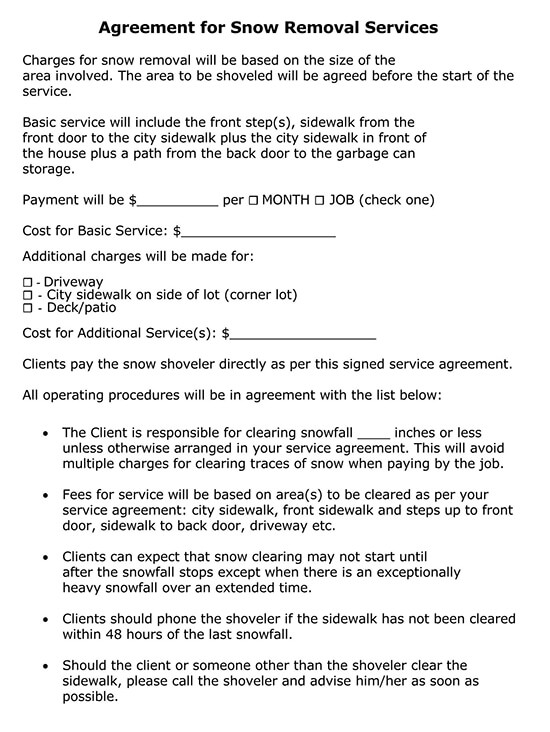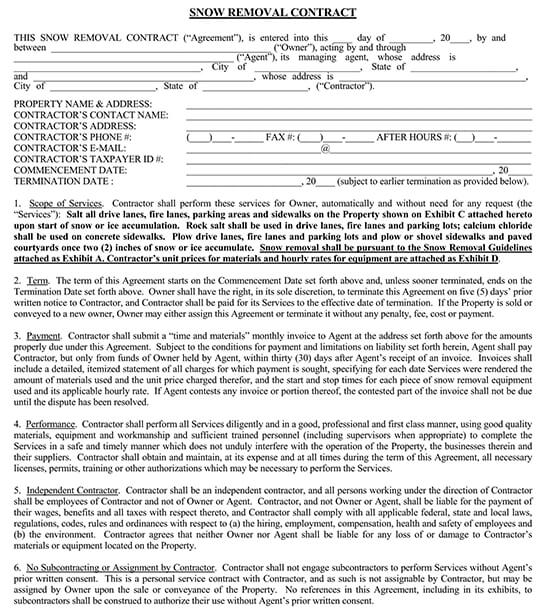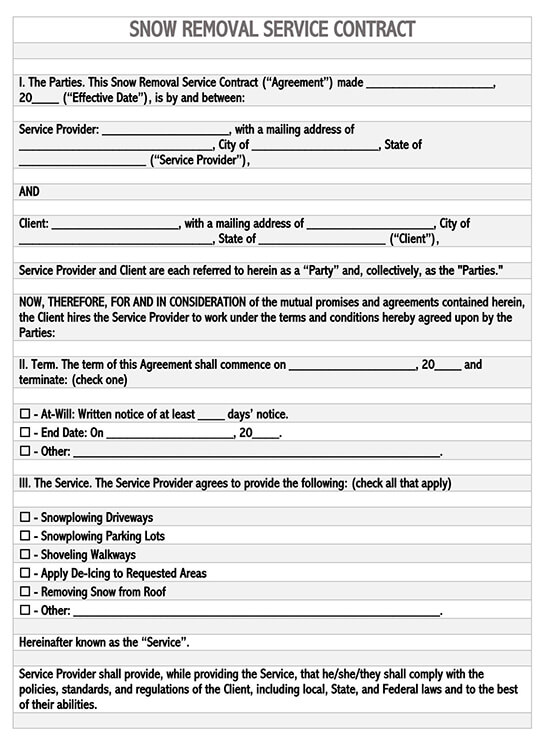When a client requires the services of an individual to remove snow from a residential or commercial property, they typically enlist said individual using a snow removal contract. For the purposes of such a contract, the individual is considered an independent contractor and is generally hired on a job-to-job basis. That being said, he/she may also be hired on a recurring basis using a longer contract. Our guide will walk you through everything you need to know about a snow removal contract.
Free Templates




What Does Snow Removal Typically Entail?
Generally, snow removal refers to the clearance of snow outside properties. This may, however, be carried out in a number of ways – some of which are more effective and efficient than others. Truck-plowing, snow-blowing, shoveling, ATV-plowing, and salting/de-icing are all viable ways in which snow can be cleared.
Each of them has their own respective pros and cons as well, which are as follows:
- Truck-plowing – Using a truck with a plow attached to shovel snow out. This is used when snow levels are particularly high. Since trucks aren’t very accurate and can’t reach tighter, smaller areas, it is typically combined with shoveling to ensure complete removal of snow.
- Snow-blowing – This method involves using a blower to clear driveways, walkways, and exterior areas. It can be very loud and time-consuming but is a fairly effective method in clearing an area of snow.
- ATV-plowing – Similar to truck-lowing, ATV-plowing refers to a method that replaces the truck with an ATV. This allows it to reach some smaller spaces. That being said, it is also combined with shoveling to clear out tight spaces, and is generally much more expensive than any of the other methods, given the price of ATVs.
- Salting – Salting involves spreading salt before, during, and after snowstorms to speeding the melting process. This is the slowest option of the lot and is only really viable when dealing with a large space, such as a university, school, or factory. It can be very economical and effective in covering a lot of areas, which is why it happens to be one of the more popular options on the list.
When Do I Need a Snow Removal Contract?
Like we mentioned earlier, you’ll need a snow removal contract if you want to hire someone to clear snow, either on a one-time basis or on a regular basis. Typically, there are two ways in which such contracts are handled:
- One-time basis – A client may simply hire an individual contractor to do the job on a one-time basis. This is fairly straightforward and requires a simple contract, with very little legal jargon.
- Recurring basis – A client may hire an independent contractor to do the job on a recurring basis. This may include variables like emergency or priority services, as well as additional stipulations, such as making the contractor clear snow immediately after a snowstorm. Drafting such a contract involves adding a few more clauses and conditions to a barebones snow removal contract.
Drafting a Snow Removal Contract
As mentioned earlier, drafting a snow removal contract is a fairly straightforward process. Apart from the scope of the job, payment, and additional conditions in case of a recurring, long-term contract, there isn’t much that needs to be added. To help you out, we’ve come up with a snow removal contract template that can be found below:
SNOW REMOVAL CONTRACT TEMPLATE
This agreement is hereby enforceable upon signature as of the date __.
The “Client”, (Client name) and the “Contractor” (Contractor name) hereby agree to the following terms and conditions laid out in the snow removal contract;
I. TERM
The client and the contractor hereby agree that the services are to be performed;
(a) One-time only, on the date of.
(b) Through the course of (Start date) to __ (End date)
(In the case of a long-term contract, the client will also have to attach a schedule or put down when exactly they would require snow removal services.)
II. THE SERVICES
The contractor hereby agrees to perform the following services;
(Here, the contractor will have to explain what services they are providing. This includes things like truck-lowing, de-icing, ATV-plowing, and shoveling. Additionally, they may add things like emergency or priority services as well, if requested.)
III. PAYMENT
The client hereby agrees to compensate the contractor in one of the following ways; (Select one.)
(a) A fee of $__/session.
(b) A fee of $__ for the entirety of the term of the contract.
(c) Other __ (Please explain.)
(Typically, snow removal is charged for the per session and not according to the amount of snow. Additionally, service providers may charge more in case of extremely low temperatures or may have varying charges depending on temperature. The service provider should be sure to list the specifics here.)
IV. ADDITIONAL CLAUSES
Any other additional clauses may be inserted here. This usually includes things like emergency services, priority service, safety and damages clauses, and the like.
V. THE AGREEMENT IN ITS ENTIRETY
The agreement explicitly detailed above hereby represents the entirety of the arrangement between the parties and hereby overrides any previous or existing agreement, contractual or not, that may have been in place prior to the signing of this contract. No additional clauses will be binding unless agreed upon by both parties.
The parties hereby agree to the aforementioned terms and conditions.
CLIENT NAME __
CLIENT SIGNATURE DATE __
CONTRACTOR NAME _
CONTRACTOR SIGNATURE DATE __












